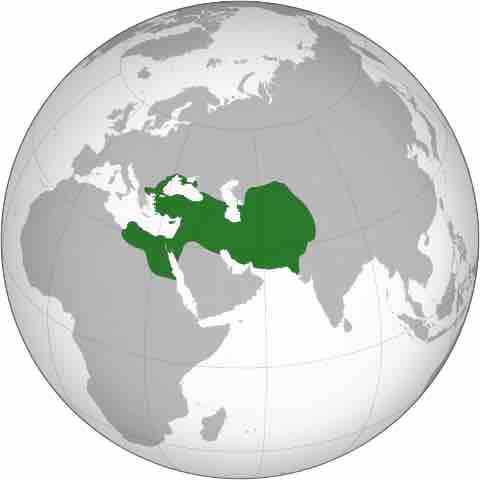Persia, centered around present-day Iran, was the site of a vast empire that existed in three general phases. The Achaemenids (550–330 BCE) established the first Persian Empire under Cyrus the Great, who quickly expanded the empire's borders. Zoroastrianism, an ancient monotheistic religion, dominated the Persian Empire until Islam supplanted it in the seventh century CE. While the religion was unique, the art of the empire was largely syncretic, combining the styles of diverse conquered and neighboring peoples. The result was a new, unique Persian style.

Early Persian Empire
In the Achaemenid period, the Persian Empire stretched across a vast swath of the Middle East into northern Africa and southern Europe.
Metalworking
One artistic technique incorporated from other cultures involved the smithing and hammering of gold, possibly adopted from the Medes. The most common surviving metal objects are ceremonial drinking cups called rhyta made of gold and silver. Rhyta were used in prehistoric Aegean and Greek cultures, most notably the Mycenaeans in the sixteenth century BCE. The gold rhyton below, which bears a stylized ram's head in relief, dates to the Achaemenid period.
Gold rhyton (550–330 BCE)
Better known than ceremonial rhyta is the Oxus Treasure, a 180-piece trove of reliefs, figurines, jewelry, and coins made of gold and silver. The treasure is important because it demonstrates the variety of forms in which metal was worked during the early Persian Empire. The gold chariot below demonstrates the precision possible with small sculptures and includes a small votive based on the Egyptian god Bes.
Gold chariot from Oxus Treasure, amalgamated from fragments of other objects in the trove
The griffin-headed bracelet also found in the treasure was once inlaid with enamel and precious stones. Once thought to have originated with the ancient Egyptians, the manner of goldsmithing evident in the amulet was later found in Assyrian art. The style of the animals originated with the Scythians, who inhabited the Steppes of Russia.
Bracelet from the Oxus Treasure
Indentations show where the bracelet once held enamel and stone inlay.
Cyrus the Great
Persian art incorporated not only the styles of conquered peoples but also their languages. A large bas relief representing Cyrus the Great as a four-winged guardian figure proclaims his rank and ethnicity as an Achaemenidian in three languages. The stylized profile pose in which the king stands recalls the dominant Egyptian style of depicting the human body in art.
Cyrus the Great as a winged guardian figure
This stylized relief of Cyrus borrows from the Egyptian style of depicting the human body and proclaims the king's ethnicity and rank in three languages.
Cyrus is believed to have died in December 530 BCE and was interred in a tomb that further demonstrates the syncretism of Persian art. The load-bearing tomb, pyramidal-roofed, sits atop a geometric mound that resembles a stepped pyramid of Pre-Dynastic Egypt. Despite the razing of the original city centuries ago, the tomb remains largely intact.
Tomb of Cyrus the Great
Syncretic attributes include the pyramidal base of the tomb.